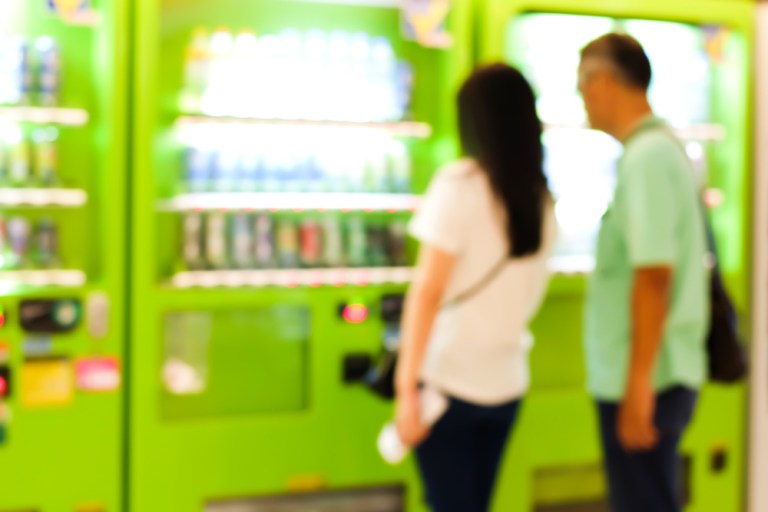USAT CEO On The Unattended Retail OS

Following the slow implosion of brick-and-mortar retail, what phoenix will rise from the ashes? Will the world be left to choose between a small number of behemoths and live with that as the new retail normal?
Consumers, says Stephen Herbert, chairman and CEO of USA Technologies (USAT), want choices — but what they also want is a new retail experience. And from his perch, providing cashless solutions to unattended retail operators, Herbert believes that self-service kiosks and unattended retail avenues could be a big part of the answer.
“Consumers need to be served in a different way as [the brick-and-mortar industry] goes through this metamorphosis,” says Herbert. “We think that it will create more opportunities from a self-serve or unattended retail perspective to deliver goods and services.”
Unattended retail as a category, Herbert emphasized, has evolved well beyond vending machines in hospital waiting rooms or employee-less micro-markets popping up in offices across the U.S. If you’ve ever stuck your house key into a machine at Home Depot to make a copy, gotten a custom tag engraved for your dog at Petco or ordered a Starbucks coffee from a kiosk instead of a barista, you’ve been a customer of unattended retail.
But in a marked change from the “old days,” many of these new unattended retail settings don’t take cash. “The nature of the use cases these kiosks support has changed,” Herbert remarked, “as has the consumer’s appetite for using digital payments to pay. Unattended retail needs to keep pace.”
It’s in response to that shift that USA Technologies has been working with unattended retail operators to develop and implement new ways to pay. Starbucks coffee kiosks and electric car charging stations are but a few of these new retail options that, by nature, can only accept electronic payments, though the actual types may vary — from credit and debit cards to eWallets via NFC (near field communication) readers.
Self-service retailers that don’t heed this shift, Herbert says, have likely signed their own death warrant; businesses can’t afford to let potential customers walk by their locations because they don’t have enough money in their pocket to buy what they want or need.
But Herbert is also quick to point out that unattended retail is about more than just going cashless. It’s about adding value for the customer and increasing the level of touch that a brand can have at the point of sale. There’s also an Internet of Things (IoT) facet, with data being fed back from kiosks to let operators know if, say, their photo booth is low on paper or toner, or if the coffee maker needs to be serviced.
All of that adds up to a perfect storm of opportunity, if you ask Herbert. Which makes USAT a tornado chaser. Herbert estimates that there are between 13 million and 15 million potential merchant location opportunities for unattended retail. And with brick-and-mortar businesses weakening more each day, the current retail equation now has a large emerging market on one side with total fragmentation on the other. At the same time, the payments space is seeing a shakeup as people demand to pay with other methods besides cash.
Recognizing and seizing that opportunity is one of the reasons that USAT went into the market to raise capital to expand. As the platform grows, it must, like most successful platforms today, become more than just a platform. It must offer new capabilities in order to stay ahead.
The public offering consisted of roughly $34.5 million of shares to be sold, with an expected option for the underwriters to purchase up to $5.2 million in additional shares of common stock over a 30-day span. Herbert said the $43.1 million raised is a means of augmenting organic growth with an inorganic boost.
Herbert explained that there are two focal categories for USAT as it works to broaden its services, based on what the company believes its customers will buy and based on what will position USAT as the platform for businesses either moving into unattended retail or looking to leverage its infrastructure.
One focus is the consumer. By growing loyalty-based programs and by allowing new partners to tap into USAT’s existing network of over 13,000 customers, Herbert said that the company can add value for customers as well as increase the level of touch that brands can achieve at the point of sale.
The second focus is that IoT facet, which USAT plans to grow through partnerships with software companies in the coming months and years.
Herbert said that USAT has been on the cashless transaction frontier for 15 years and has 73 patents in force in the U.S. and beyond, including ones for the ePort family: ePort Connect, ePort Interactive and the NFC-ready ePort G-series, which can use near field communication technology to accept payments from mobile phones without requiring customers to even remove the device from their pockets.
Herbert believes that accepting these types of payments will lead to a shift as drastic as the one that followed the invention of the magnetic card stripe. Then, as now, the new methodology met with some resistance, but one day people will take these types of payment for granted, Herbert said.
Like PayPal, he remarked, the platform will power commerce across any type of unattended retail outlet, including robots — the “unattended retail OS,” as PYMNTS CEO Karen Webster put it during her discussion with Herbert.
One way USAT has already been doing that is by partnering with Blackboard to provide a backbone for services on college campuses and to enable digital payments at a variety of unattended retail kiosks using accounts that are funded and managed via the Blackboard payments platform.
“We very much see ourselves as a wheelhouse,” Herbert said. “We don’t have to own everything. We don’t have to own all of the functionality. We want to have the core services that we believe every unattended retail location would want.”